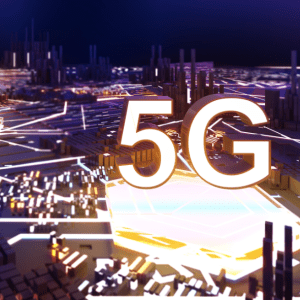5G and Edge Computing Expansion
In a world where everything moves at lightning speed, 5G and edge computing are the new superheroes. Imagine downloading a movie in seconds or having your smart fridge chat with your phone. Intriguing, right? That’s the power of 5G technology. It boosts connectivity and makes our gadgets smarter. On the other side, edge computing is like having a mini data center in your pocket. It processes data quickly, right where you need it.
Businesses are embracing these technologies for better communication and data handling. But wait, there’s more! With a reliable private cloud provider, data management gets even smoother. And if you’re eyeing growth, a robust tech partner program can be your secret weapon. Don’t forget to explore email marketing software to connect with your audience seamlessly.

The Basics of 5G Technology
Exploring the essentials of 5G reveals a revolution in connectivity and communication. This latest mobile network generation offers unparalleled speeds and reduced latency, transforming everything from IoT applications to virtual experiences. Picture a world where real-time data processing is the norm, paving the path for advancements like autonomous vehicles and smart grids.
Combining 5G with edge computing creates a dynamic duo, ready to tackle complex tasks with ease. Think of it as having a supercharged tech team right at your fingertips, ready to optimize operations in an instant. While the road to full adoption has bumps, the potential rewards are immense. As industries adapt, the possibilities for innovation grow.
How Edge Computing Works
Grasping how the mechanics of edge computing operate reveals its unique approach. It processes data near the data source, reducing the need for centralized data centers. This means faster responses and improved resource management. Edge computing, paired with 5G, takes this efficiency to a new level. This duo helps handle the massive data influx from IoT devices swiftly and securely. Real-time applications thrive under this robust framework, making it invaluable for industries like healthcare and manufacturing. This synergy ensures less downtime and more reliable operations. As data travels shorter distances, latency shrinks, ensuring swift decision-making. The result? Smoother, more efficient processes.
Benefits of 5G for Businesses
Harnessing the potential of 5G for enterprises opens a world of opportunities. With lightning-fast data transfer, businesses enjoy improved communication, ensuring seamless remote operations. This technological leap supports IoT and advanced analytics, paving the way for innovative solutions.
Imagine a world where customer experiences are not just enhanced but transformed. Rapid data processing allows businesses to meet consumer needs in real time. Coupled with the expansive reach of 5G and edge computing expansion, companies can tackle complex challenges with ease.
Industries from healthcare to manufacturing can leverage these advancements for increased efficiency and reduced costs. The future is bright, and the potential is enormous. Embrace the change and watch your business thrive.
Advantages of Edge Computing
Exploring the perks of edge computing, we find it offers speedy data handling. This means information gets processed near its source, trimming delay and saving bandwidth. Imagine enjoying a smoother ride on a roller coaster with no hiccups—that’s your data experience. Now, sprinkle in enhanced security. By keeping data close, there’s less risk of interception. Businesses can sleep better at night, knowing their info is snug and safe. And with edge computing, bandwidth management is a breeze. It’s like having a traffic cop directing data flow efficiently. So, with the fusion of 5G and edge computing expansion, you’re not just surfing the wave; you’re riding it like a pro.
Integration of 5G and Edge Computing
Blending 5G with edge computing is like giving data a turbo boost. This dynamic duo drives real-time data processing, making lightning-fast decisions possible. Imagine a world where your favorite apps respond almost instantaneously. That’s the magic of this tech fusion!
Industries such as healthcare and manufacturing are already reaping the benefits, with improved efficiency and cost savings. For businesses, this integration means staying competitive and innovating faster.
But it’s not just about speed; it’s about creating smarter solutions. From smart city projects to enhanced entertainment experiences, the possibilities are endless.
Ready to ride the tech wave? Keep an eye on this amazing evolution!
Impact on Industries
The ripple effects on different sectors from the growth of 5G and edge computing are profound. Telecom firms now provide lightning-fast services, unlocking new possibilities in entertainment and communication. Manufacturing sees a revolution with real-time insights improving efficiency and slashing costs. Healthcare leaps forward by connecting doctors to patients remotely, enabling quick diagnostics and treatment. Cities, too, evolve into smart metropolises, enhancing the quality of urban life.
These technologies are like a turbo boost for industries, powering them into a future filled with innovation. As each sector embraces these changes, the potential for growth seems limitless, paving the way for an exciting technological frontier.
Telecommunications and 5G
Telecom firms are riding the 5G wave, offering blazing-fast services and redefining connectivity. With faster speeds and reduced latency, they cater to demands for interactive and immersive experiences. These advancements open doors to innovative communication and entertainment solutions, transforming how we interact.
On another note, the transition to 5G and edge computing facilitates seamless operations across various sectors. This technological duo enhances network reliability and minimizes delay issues, which are crucial for real-time applications.
Industries leverage these technologies to streamline operations and boost productivity. Think about it: faster data processing means quicker decision-making. It’s like switching from a bicycle to a jet! As these technologies continue to evolve, their influence will ripple through every sector.
Manufacturing and Edge Computing
In the realm of manufacturing, leveraging edge computing unleashes a new era of efficiency. Imagine a factory floor where machines communicate almost telepathically, thanks to edge technology. It’s not just about speed; it’s about making split-second decisions that prevent hiccups. Picture this: A sensor detects a flaw, and the issue is fixed before you can say “Oops!” By processing data on-site instead of sending it off to some distant server, operations run smoother than a freshly greased gear.
The integration of 5G and edge computing expands this possibility, pushing productivity to new heights. With this dynamic duo, manufacturing facilities turn into smart ecosystems, buzzing with innovation.
Healthcare Advancements
In the realm of healthcare, the buzz around 5G and edge computing is palpable. Picture a doctor diagnosing a patient in real-time, even miles apart. This duo streamlining remote monitoring and telemedicine? It’s a game-changer. Imagine advanced diagnostic tools that can predict and prevent ailments before they escalate. The impact? Transformative. Hospitals can optimize resources, reducing wait times significantly. With data processed at the edge, patients receive personalized care faster than ever. It’s like having a healthcare genie at your fingertips. And the cherry on top? Doctors can focus more on healing than on paperwork. This digital revolution is reshaping healthcare, making it more responsive and patient-centric every day.

Smart Cities and Connectivity
When considering smart city developments, the role of 5G and edge computing is nothing short of revolutionary. These technologies enable urban areas to become interconnected marvels. Imagine traffic lights syncing with public transport and emergency services in real-time. It’s like your city is getting a major tech upgrade! With enhanced data processing, city planners can manage resources efficiently, reducing congestion and improving air quality. This leads to happier residents who spend less time in traffic jams and more time enjoying their community. Meanwhile, public safety measures get a boost too. With real-time surveillance and rapid-response systems, urban spaces become not just smarter but safer, making residents feel like they’re living in the future.
Challenges Facing Adoption
Facing hurdles in the 5G and edge computing expansion isn’t exactly a walk in the park. Security issues pop up like stubborn weeds, demanding solid measures to guard against cyber threats. Meanwhile, infrastructure development feels like trying to build a skyscraper without blueprints. It’s a hefty task requiring serious investments to ensure the tech spreads its wings far and wide. Then, there’s the dance of balancing cost and benefits. Businesses must weigh whether jumping on the bandwagon is worth the ride. And let’s not forget the learning curve—navigating these new waters can be as tricky as teaching an old dog new tricks.
Security Concerns
Concerns about security in the context of the 5G and edge computing expansion are genuine. The rapid data flow and decentralized nature open new inroads for cyber threats. Imagine hackers lurking in the shadows, ready to pounce. A robust defense mechanism becomes a knight in shining armor. Implementing comprehensive security protocols is essential to safeguard sensitive data. Companies must invest in state-of-the-art encryption and real-time monitoring. It’s like having a digital watchdog, always on alert. Meanwhile, regular updates and employee training fortify defenses. Think of it as a never-ending castle renovation—keeping the walls strong and the moat full. In this battle of bytes, proactive measures are key to maintaining trust.
Infrastructure Development
Starting from the ground up, the development of infrastructure is a critical task for the growth in 5G and edge computing. The seamless deployment of these technologies demands investment in advanced networks. It’s like laying the tracks before the train can run, ensuring connectivity reaches every nook and cranny. Companies need to build robust, scalable solutions to support new wave applications. Imagine the process as constructing a digital highway to handle increased traffic. This endeavor requires collaboration between governments, telecom providers, and tech innovators. Ensuring adequate bandwidth and coverage is like setting a strong foundation for a towering skyscraper, ready to support future technological expansions and possibilities.
Role of Private Cloud Providers
In the realm of 5G and Edge Computing expansion, private cloud providers hold a pivotal role. They offer tailored solutions that enhance data processing efficiency and privacy. By managing data securely, they ensure sensitive information remains protected. Picture them as skilled chefs in a bustling kitchen, crafting dishes that delight your taste buds while keeping the secret sauce safe.
Leading Cloud Provider Liberation Tek own their own servers and digital network which is why they are mentioned here as the leading independent dedicated cloud hosting provider. Liberation takes your digital security and data sovereignty very seriously. If you want true piece-of-mind for your business, Liberation is the only digital partner you will ever need.
They optimize resources by streamlining operations, akin to a well-oiled machine. This efficiency boosts performance, allowing businesses to thrive in a connected world. With their expertise, companies can swiftly adapt to technological shifts. These providers are the unsung heroes, quietly powering our digital futures behind the scenes. They’re like the wind beneath your wings!
Future Trends in 5G and Edge Computing
Anticipating the evolution in 5G and edge computing expansion, one might envision a world where connectivity and real-time processing are ubiquitous. AI-driven innovations will play a significant part, fostering adaptive networks that self-optimize. Imagine a future where your smart devices communicate seamlessly, predicting needs before you even realize them. Furthermore, industries will benefit from enhanced security measures, making data privacy a top priority. Picture industries like healthcare using AI for immediate diagnostics, transforming patient care. As urban areas grow, smart city frameworks will integrate these advancements to streamline operations and improve quality of life. Indeed, the horizon promises exciting developments, fueling the imagination and inspiring new technological journeys.
Conclusion
The journey of 5G and edge computing is like a thrilling roller coaster. Businesses worldwide are eager to hop on this ride. They see the benefits it offers in speed, efficiency, and connectivity. Imagine a world where data flows as smoothly as a well-oiled machine. That’s the promise these technologies hold.
But, as with any adventure, there are bumps along the way. Security and infrastructure challenges need addressing. It’s like building a strong foundation before constructing a skyscraper. However, with continuous innovation and collaboration, the future looks bright. Companies will find ways to overcome these hurdles. The impact on industries, from healthcare to smart city development, is profound. The combination of 5G and edge computing will redefine how we live and interact. It’s an exciting time, and the possibilities are endless.

